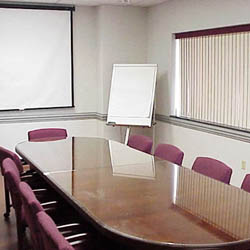
Calculating PAG and NAG
Loudspeakers are placed throughout the conference room.
The closest loudspeaker to the talker is placed 10 feet from the talker’s microphone.
The closest loudspeaker to the farthest listener is placed 6 feet from the listener.
• How much acoustic gain can the sound system supply without causing feedback if only 1 microphone is on? (PAG)
• How much acoustic gain is required for the farthest listener to hear at an equivalent level to the nearest listener? (NAG)
• Can the farthest listener receive enough gain without feedback?
Using the PAG formula:
PAG = 20Log((D0 * D1)/(D2 * Ds)) – 10LogNOM – 6 dB
PAG = 20Log((20*10)/(6*2) – 6 dB
PAG = 18 dB (to nearest whole dB)
Using the NAG formula:
NAG = 20Log(D0/Dn)
NAG = 20Log(20/4)
NAG = 14 dB
Since PAG is the maximum calculated level that is obtainable without feedback and it is 4 dB greater than the calculated NAG level, the sound system should operate without feedback.
Speech Reinforcement Zones
To perform speech reinforcement in a large conference room or auditorium, it is best to use automatic microphone mixers and divide the room into zones.
The zones are made up of both microphone and loudspeaker groups.
A microphone group is a mix of the post-gate outputs from the individual microphones within a zone. Each loudspeaker group has it own amplifier to allow selective audio sources to be played within a zone.
Grouping microphones within a zone allows a microphone group to be played at selected loudspeaker groups. Zoning allows microphones within a zone to be played on loudspeakers of other zones while disabling them from being played within their own zone.
This is typically called a mix-minus zone system.
Some system designers use relays to disable a loudspeaker group when a microphone within its zone gates-on. Use caution with this design type with acoustic echo cancellers. Changes in the acoustic properties of a room, caused by switching loudspeakers, will cause the echo canceller to loose its adaptation and return echo.
The simplest example of using zones for speech reinforcement uses only two zones, with each zone having one microphone and one ceiling loudspeaker.
A microphone and ceiling loudspeaker are placed at each end of a conference table. Zone 1 contains the left microphone and ceiling loudspeaker and Zone 2 contains the right microphone and ceiling loudspeaker.
To perform speech reinforcement, Zone 1’s microphone’s audio signal is feed only to Zone 2’s ceiling loudspeaker and Zone 2’s microphone’s audio signal is feed only to Zone 1’s ceiling loudspeaker.

